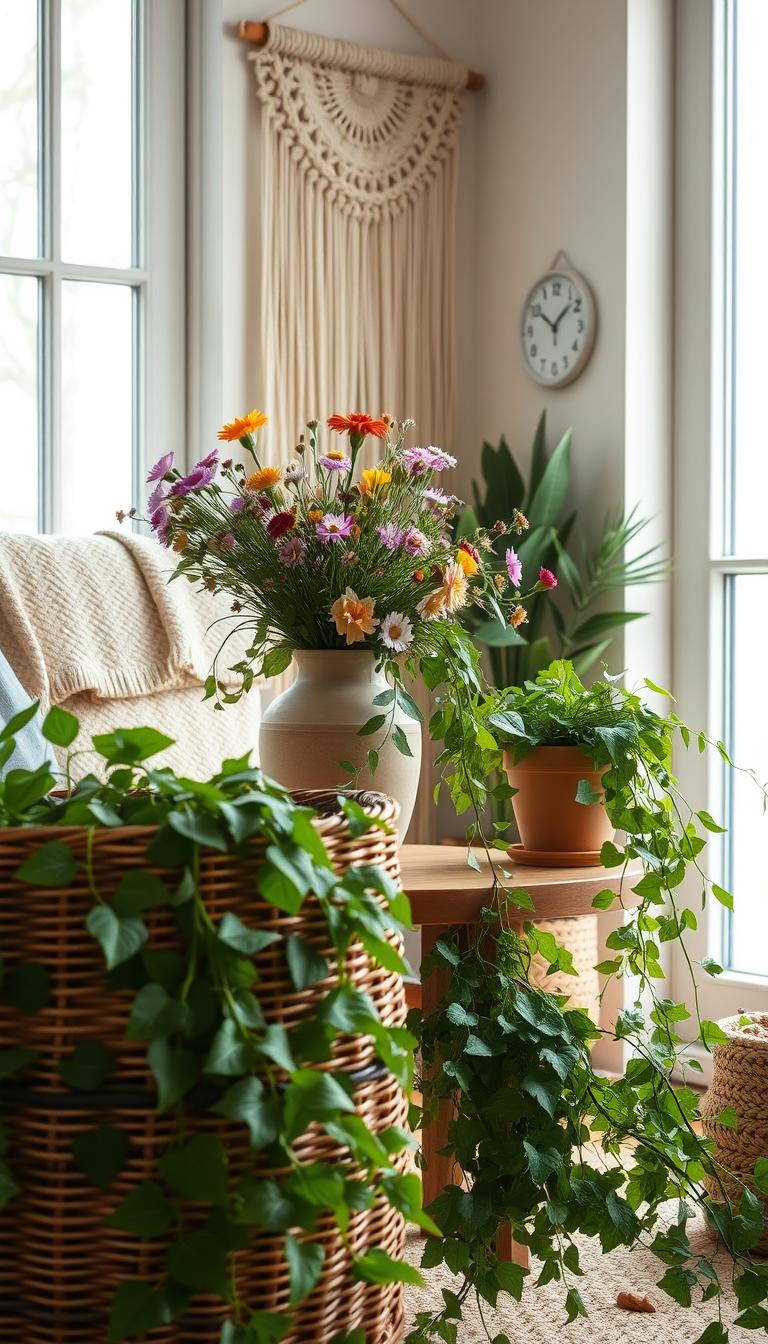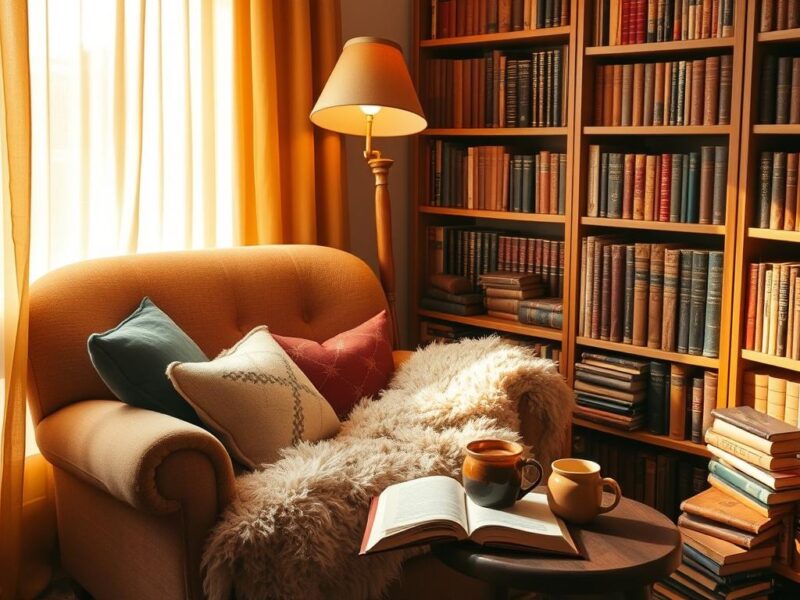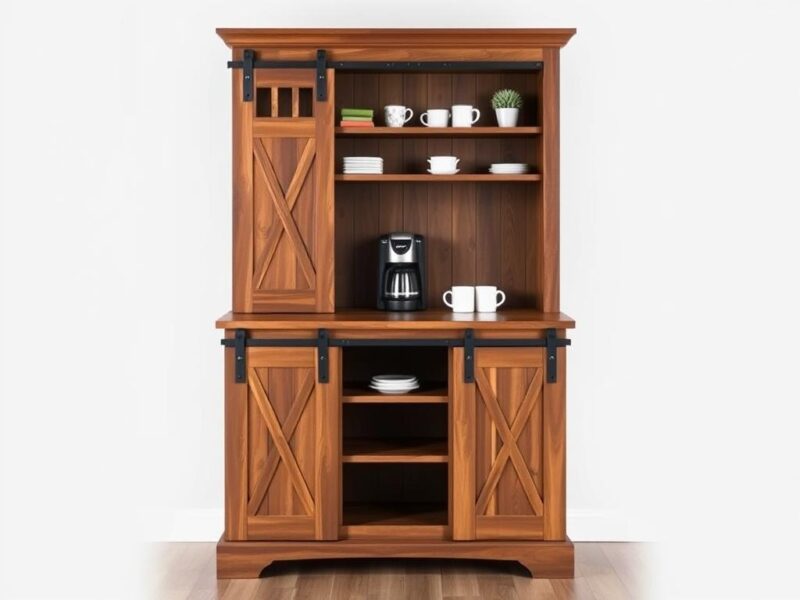Did you know 70% of people feel happier at home and work with plants around? This shows how powerful biophilic design is. It’s changing how we live. By using easy biophilic design tips, you can make your home look great and feel better.
Biophilic design connects us to nature indoors. It’s more than just plants. It makes us less stressed, more creative, and improves air. Now, we want natural things in our homes more than ever.
Biophilic design has many ways to make your home a natural haven. You can use natural light and organic materials. These simple ideas make your home look good and feel good too.
Key Takeaways
- Biophilic design improves home atmosphere for 70% of people
- Nature-inspired decor reduces stress and boosts creativity
- Incorporating plants can purify air and increase productivity
- Natural light exposure regulates mood and sleep patterns
- Biophilic elements can increase property value and appeal
Understanding Biophilic Design: Connecting with Nature Indoors
Biophilic design brings nature inside, making spaces that feel like the outdoors. It’s more than just plants. It’s about making places that feel right to us.
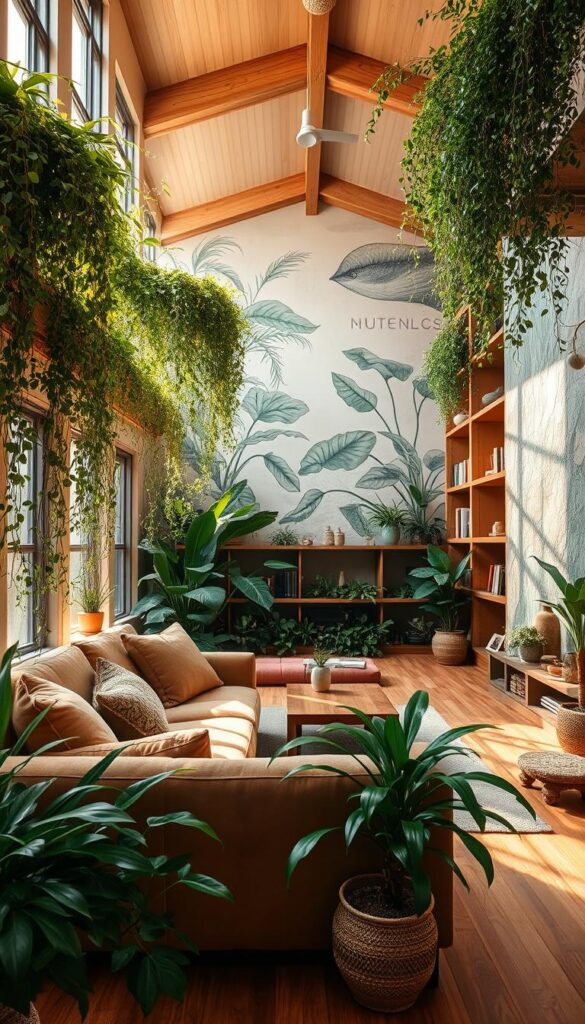
What is Biophilic Design?
Biophilic design started in the 1980s. It adds natural things to our homes. It’s not just pretty; it makes us feel better. This way of designing homes is all about biophilic interiors that make us happy.
- Natural light and views
- Plants and living walls
- Water features
- Natural materials like wood and stone
- Earth-tone color palettes
The Science Behind Nature-Inspired Spaces
Studies show biophilic design is good for us. It can lower stress and blood pressure. Even small things, like plants, can make us feel better.
Benefits for Mental and Physical Wellbeing
Biophilic design in your home has many benefits:
- Less anxiety and stress
- Better mood and work
- Cleaner air and more oxygen
- Healthier sleep from natural light
Using biophilic design means more than just a pretty home. It’s about being healthy and happy. Big windows or living walls can make your home better for you.
Easy Biophilic Design Tips for Maximum Impact
Bringing nature into your home is easy and affordable. A few simple steps can make your space feel more natural. This can make you feel better and connect you with nature.
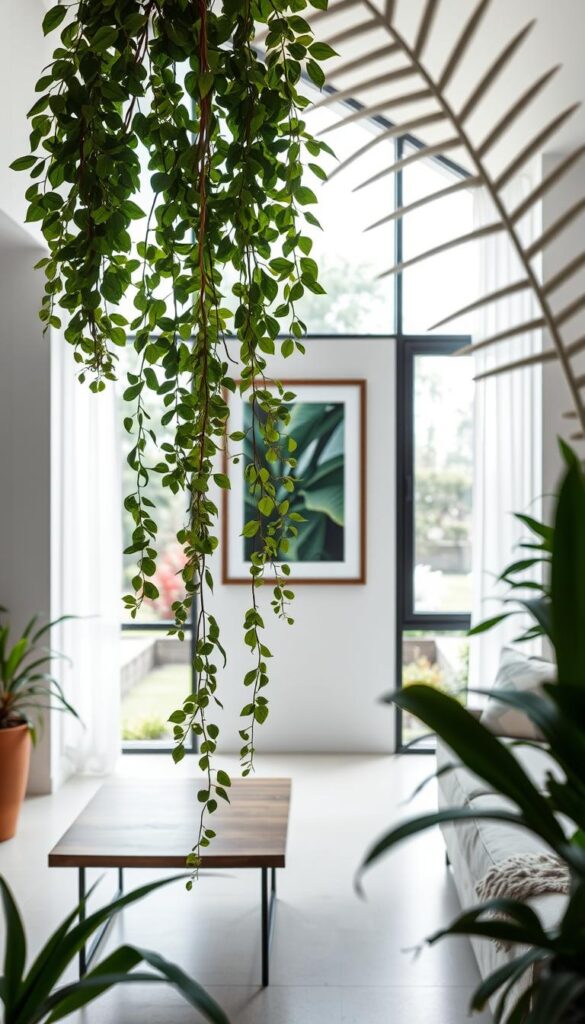
First, let in more natural light. Most people like spaces with lots of daylight. Mirrors can make rooms look brighter and bigger.
Adding plants is also a good idea. They can make you feel less stressed and smarter.
Choose materials like bamboo or cork for your decor. They look good and are better for the planet. Natural textures can make your space feel warmer and more welcoming.
- Use natural light and mirrors to brighten spaces
- Add indoor plants to reduce stress and boost cognition
- Incorporate sustainable materials and natural textures
- Create a seamless indoor-outdoor flow
These tips can make your home beautiful and healthy. You’ll be helping the planet too. Get ready to make your home a nature-inspired haven!
Maximizing Natural Light and Views
Natural light is key to making your home feel like the outdoors. It makes you happy, helps your body clock, and keeps you healthy. Let’s see how to get more daylight and views in your home.
Strategic Window Placement
Where you put your windows matters a lot. South-facing windows get sunlight all day. East and west-facing windows give you morning and evening light. Think about adding skylights or clerestory windows for vertical light without losing privacy.
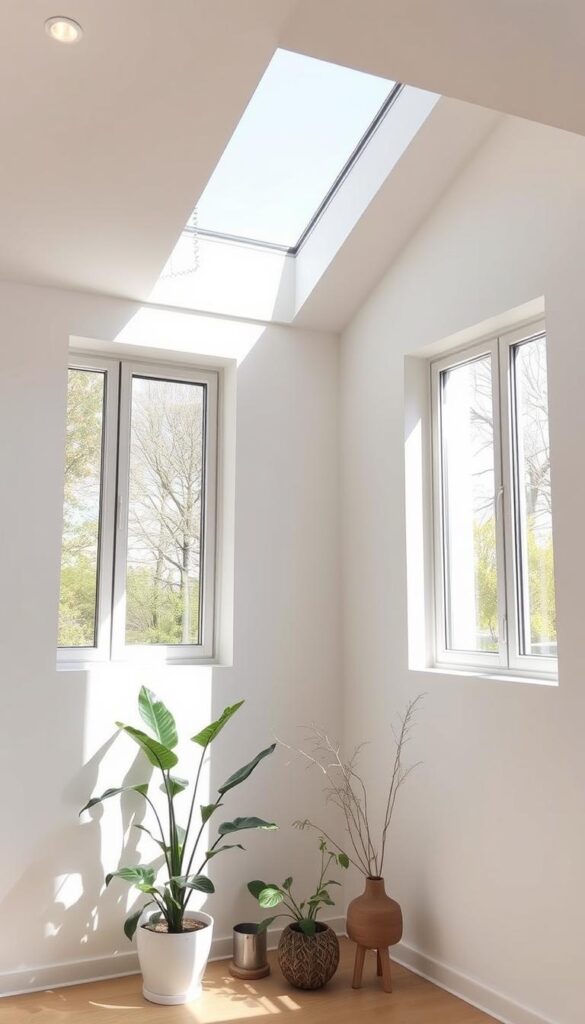
Using Mirrors and Reflective Surfaces
Mirrors and shiny surfaces make rooms look brighter and bigger. Put mirrors by windows to spread light around. Light-colored walls also help light move around your home.
Indoor-Outdoor Flow Solutions
Make your home feel like it’s part of the outdoors with big windows or glass doors. This brings in more light and lets you feel close to nature. Stylish Japandi decorating ideas use these to mix indoors and outdoors well.
Using these tips, you can make your home bright and nature-like. Remember, it’s not just about looks. It’s about making a healthier, greener home that’s good for you.
Incorporating Natural Materials and Textures
Bring the outdoors in by using natural materials in design. Wood, stone, and organic fibers connect you to nature. They make your home look beautiful and feel good.
Start with wooden flooring for a warm feel. Add stone accent walls for texture and interest. Use leather furniture and wool rugs for a cozy touch.
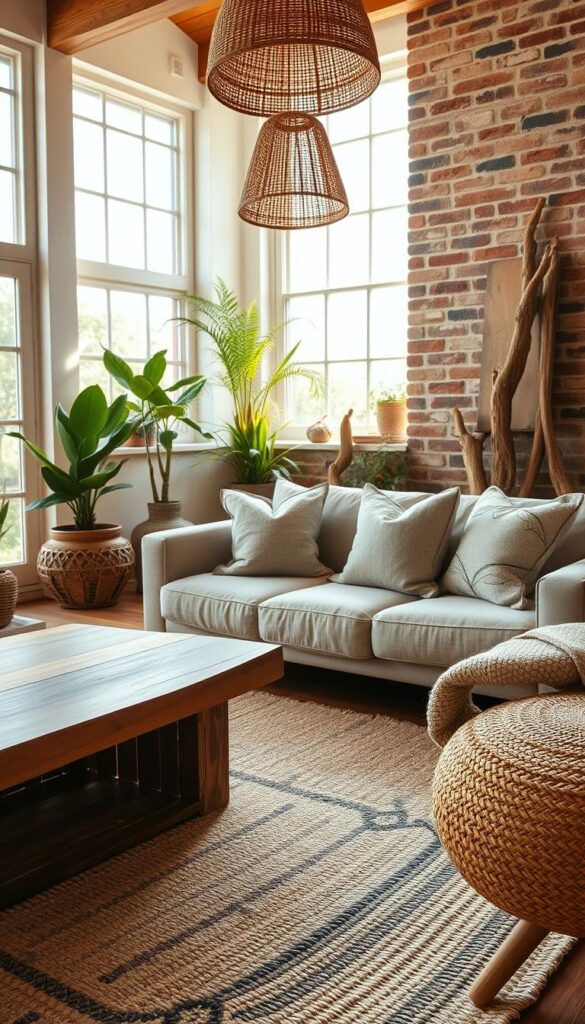
Make indoor and outdoor spaces feel the same. Use stone for both a pathway and a wall. This makes your home feel connected to nature.
Don’t forget small touches. Woven baskets, clay pots, and cork add character. They make your space feel alive and welcoming.
Natural materials get better with age. A wooden table gets a beautiful patina. Leather gets softer. Enjoy these changes as your home’s story grows.
Creating Living Green Spaces Indoors
Bring nature inside with indoor gardening. Green living spaces do more than look good. They make the air cleaner, lower stress, and make you feel better. Let’s see how to make your home full of life.
Low-Maintenance Plant Selection
Find plants that need little care. Snake plants, pothos, and ZZ plants are great. They clean the air and grow well in different light. Put them in places where they can make a big difference.
Vertical Gardens and Living Walls
Vertical gardens make a big statement. They save space and turn walls into green walls. Studies show they can really clean the air. Use systems or make your own frames to create a masterpiece.
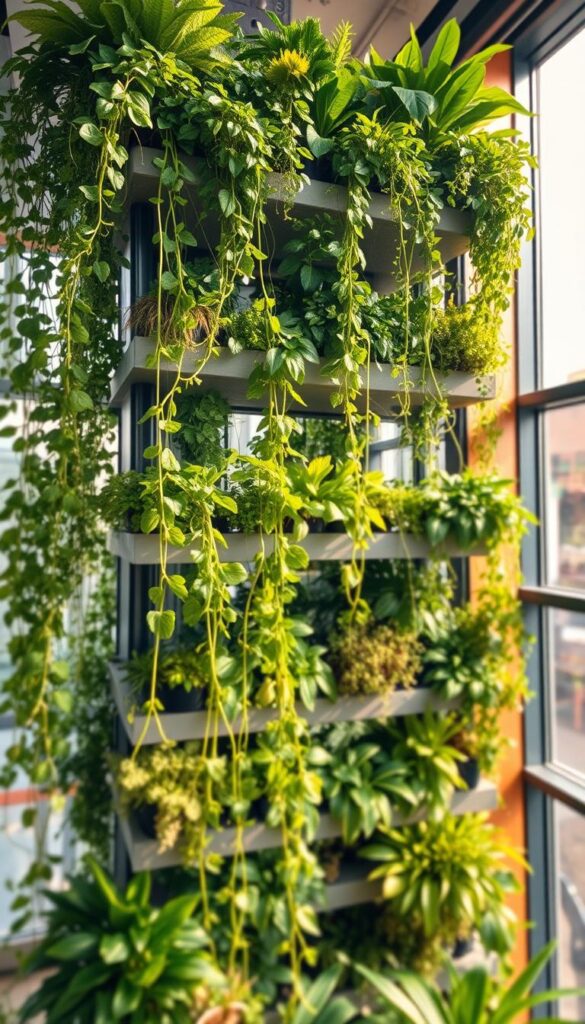
Creative Plant Display Ideas
Be creative with how you display plants. Hang them from the ceiling with macramé. Use old furniture as planters. Mix plants of different heights for a lively look. Use different textures and colors to add interest. Indoor gardening is like art – let your imagination run wild!
Green spaces do more than make your home look nice. They connect you with nature and improve your health. A 2014 study found being around green spaces boosts mental health. So, start indoor gardening and turn your home into a lively, air-filled paradise.
Natural Colors and Patterns in Design
Bringing nature into your home makes it calm. Use earth tones, organic patterns, and natural shapes. This turns your space into a peaceful place.
Earth-Tone Color Palettes
Earth tones make us feel calm and connected. Pick warm browns, soft greens, and muted blues for walls and furniture. These colors help us relax and feel better.
Mix different shades to add depth and interest. This makes your rooms more exciting.
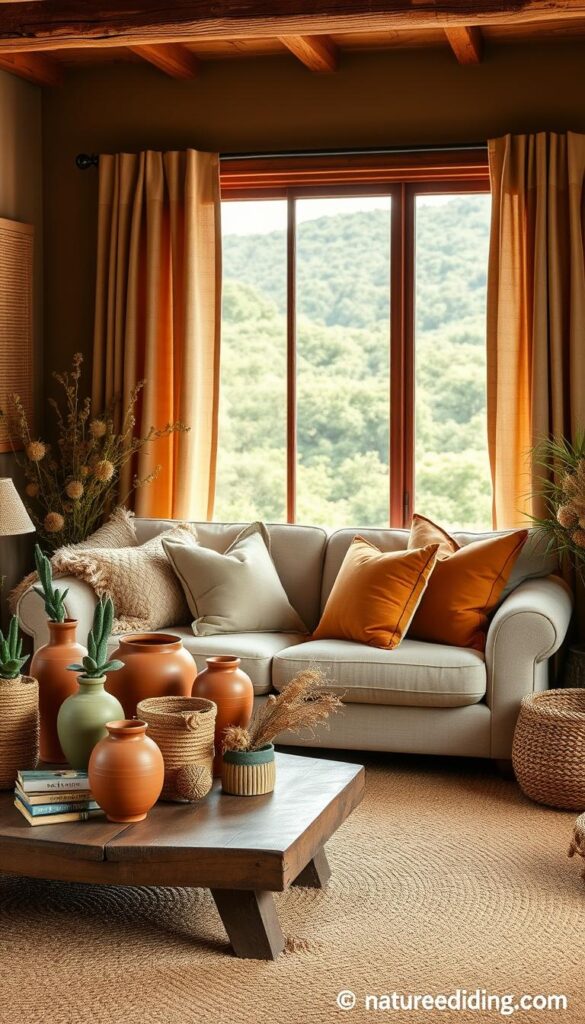
Nature-Inspired Patterns and Motifs
Use patterns from nature to add beauty. Leaf prints, floral designs, and shapes found in nature are great. Botanical prints and patterns add timeless charm. Use them in wallpaper, textiles, or artwork to draw attention.
Organic Shapes and Forms
Choose furniture and decor with curved lines and flowing shapes. Round tables, wavy mirrors, and irregular rugs look like nature. They make your space feel soft and welcoming.
By using these natural design ideas, you create a refreshing and harmonious space.
Conclusion
Using biophilic design in your home is a great way to make it better for you. It brings nature inside, making your space more than just a place to live. It’s a way to improve your life.
People spend a lot of time inside, so making homes feel like nature is key. Biophilic design can make you feel less stressed and more creative. It can even help you get better faster.
Big companies like Microsoft and Amazon have seen how it works. They’ve noticed their workers are happier and do better when they have nature around them.
Biophilic design isn’t just about plants. It’s also about colors, light, and air. Making these changes can really help your mood and health. It’s a smart way to make your home better for you and the planet.
